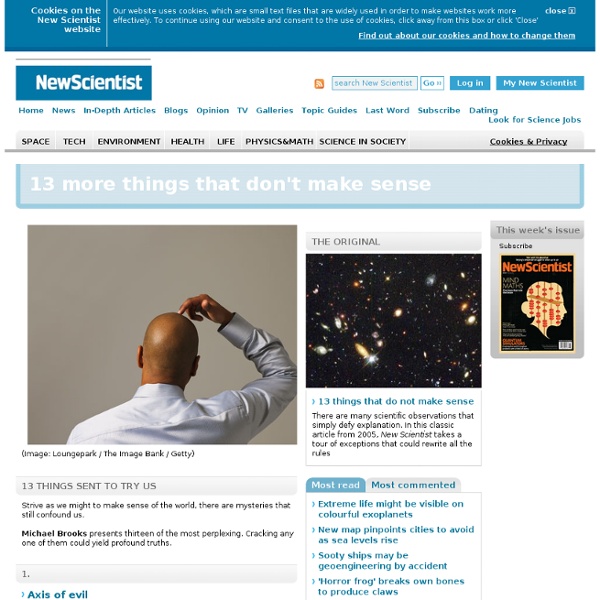Earth As Seen from Mars - Marvin the Martian's front lawn
Marvin the Martian's front lawn - Franny Wentzel - Saturday, April 24th, 2010 : goo [previous] :: [next] This is the first image ever taken of Earth from the surface of a planet beyond the Moon. It was taken by the Mars Exploration Rover Spirit one hour before sunrise on the 63rd Martian day, or sol, of its mission. (March 8, 2004) The image is a mosaic of images taken by the rover's navigation camera showing a broad view of the sky, and an image taken by the rover's panoramic camera of Earth.
Bizarre animals that are new to science - Image 9
Old species, new insights It's not only new species that can amaze scientists. These creatures, discovered decades ago, are only now giving up their secrets. The fish with a cockpit head
99 Useful Resources for Graphic Designers
Articles September 27, 2007 I have used every one of these resources as a graphic designer and website developer and have hand picked all of these resources based on their usefulness and overall quality. I hope you find these resources as useful as I do! Enjoy!
Ensign Software - ESPL: Dances of the Planets
The planets in the heavens move in exquisite orbital patterns, dancing to the Music of the Cosmos. There is more mathematical and geometric harmony than we realize. The idea for this article is from a book Larry Pesavento shared with me.
logy Magazine
As corals continue to decline in abundance around the world, researchers are turning their attention to a possible cause that’s almost totally unexplored – viral disease. It appears the corals that form such important parts of marine ecosystems harbor many different viruses – particularly herpes. And although they don’t get runny noses or stomach upset, corals also are home to the adenoviruses and other viral families that can cause human colds and gastrointestinal disease. In a research review published in the Journal of Experimental Marine Biology and Ecology, scientists point out that coral declines are reaching crisis proportions but little has been done so far to explore viral disease as one of the mechanisms for this problem.
Moss Graffiti—Next Big Thing
This is the kind of thing they can't buff, and if "they" can, then we don't know how. We are talking about Moss Graffiti, and if you play your cards right, this is what you can be doing tonight to really "green" up the neighborhood. This is why we read Popular Mechanics.
2011 May 7 - Dawn of the Planets
Discover the cosmos! Each day a different image or photograph of our fascinating universe is featured, along with a brief explanation written by a professional astronomer. 2011 May 7
The Experimental Food Society Spectacular
*rugenius in food+drink , 11:58 From our London based editor, Justine Aw… Some fun highlights from this year’s Experimental Food Society Spectacular exhibition housed in Brick Lane’s Old Truman Brewery!
Tuning In To The Brain's 'Cocktail Party Effect'
Scientists are beginning to understand how the human brain accomplishes a remarkable trick known as the cocktail party effect. It's what allows us to pick out the words from just one speaker even when we're in a room full of other voices that are just as loud. For decades, scientists have puzzled over how our brain is able to focus on certain sounds while filtering out others. Now they say they're finding clues, thanks to new research on birds and bats. Birds don't spend much time at cocktail parties, but they do face a similar auditory challenge, says Frederic Theunissen of the University of California, Berkeley.



